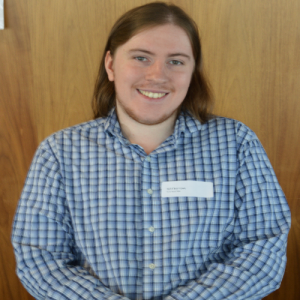This year, we have a joint win for our Month 13 Presentation Prize: congratulations to second year PGRs Joe Pitfield and Will Borrows. The prize was a £50 voucher.
The Month 13 presentations are given each October, where the PGRs give a presentation on their work to date and feedback scores are given by their peers. Joe’s presentation was titled ‘The search for new materials’ and Will’s was titled ‘Simulating heat flow in thermoacoustic devices’. Please find their abstracts below.
The search for new materials
Joe Pitfield
Abstract:
It is commonly understood that there is no universal a priori approach to predicting the nature of boundary regions between materials, nor one to enable theoretical design of novel materials within such regions. We present a developing method (RAFFLE; pseudo Random Approach For Finding (Local) Energy minima) learning from existing structural prediction methods [2][1], for the pseudo-random generation of atomic structures. Materials are characterised by decomposition of both bond angle and length, with these characterisations applied retroactively to generate new structures with profiles indicative of the isolated characteristic (in these cases, Energy of formation). This method is able to predict the existence of a series of structures of known one, two and three element systems, along with other geometries known [3] to exist for chemically similar structures (for the Transition metal dichalcogenides, both H and T phase structures predicted) and multiple stable phases identical stoichiometry structures (hexagonal and tetragonal and for Carbon) along with scopes over varying stoichiometries (HCP and FCC aluminium).

References
[1] Chris J. Pickard and R. J. Needs. ‘High-Pressure Phases of Silane’. Phys. Rev. Lett.97 (4 July 2006), p. 045504.
[2] Yanchao Wang et al. ‘Crystal structure prediction via particle-swarm optimization’. Phys. Rev. B82 (9 Sept. 2010), p. 094116.
[3] Anubhav Jain et al. ‘The Materials Project: A materials genome approach to accelerating materials innovation’. APL Materials1.1 (2013), p. 011002.
Simulating heat flow in thermoacoustic devices
Will Borrows
Abstract:
The thermoacoustic effect is a process by which sound is produced by the Joule heating of a thin film (a ‘thermophone’) with an alternating current [1]. While this effect has been known for more than a century [2], recent advances in the fabrication of nano-scale films have rejuvenated the field of thermoacoustics [3,4]. Despite this, thermophones have struggled to present themselves as an alternative to more conventional piezoacoustic speakers due to their low output efficiency.
Here we present an examination into the propagation of heat within and around a thermophone through both finite-element and finite-difference simulation of a device. We do this in order to gain a greater understanding behind the thermal processes which hinder thermophone efficiency. Of particular note is the effect of the Maxwell-Cattaneo correction to Fourier’s heat law [5], which accounts for the non-instantaneous nature of heat flow. By measuring the effect of this correction on the thermal fluctuations at the boundary between the thermophone and its surrounding medium, we are able to determine a trend for this correction. Going forward, we intend to more accurately calculate the expected sound output of a thermoacoustic device, as well as quantify the effects of this correction on the thermoacoustic efficiency.
References
[1] Ding, H. Nanoscale, 2019, v.11, p.5839-5860
[2] Preece, W. H. Proceedings of the Royal Society of London, 1880
[3] Shinoda, H. et al. Nature, 1999, v.400, p.853-855
[4] Xiao, L. et al. Nano Letters, 2008, v.8, no.12, p.4539-4545
[5] Cattaneo, C. Comptes Rendus Hebdomadaires des Seances de l’Academie des Sciences, 1958, v.145, p.431-433

